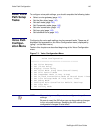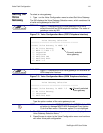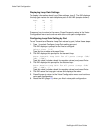
NetEngine IAD User Guide
Voice Path Configuration 142
4. Reset the IAD (page 15) when you finish voice path configuration.
When you choose a specific voice gateway, the IAD displays option E on
the Main menu specifically for the voice gateway you’ve selected. Proceed
to the section for configuring a specific gateway:
MGCP 0.1/NCS 1.0—page 151
CopperCom—page 155
Jetstream—page 158
AAL2/LES CAS—page 161
MGCP 1.0—page 151
AAL2/LES ELCP—page 165
Setting
Jitter Delay
Inter-arrival jitter is the difference in relative transit time for two packets. It
is the difference between the packet's RTP time-stamp and the receiver's
clock at the time of arrival of the packet.
As shown in the equation below, this is equivalent to the difference in the
relative transit time for two packets: the relative transit time is the
difference between a packet's RTP time-stamp and the receivers clock at
the time of arrival, measured in the same units.
If Si is the RTP time-stamp from packet i and Ri is the time of arrival in
RTP time-stamp units for packet i, then for two packets i and j, D may be
expressed as:
D(ij) = (Rj -Ri) -(Sj -Si) = (Rj -Sj) -(Ri -Si)
The interval jitter is calculated continuously as each data packet i is
received from source SSRC-n, using this difference D for that packet and
of the previous packet i-1 in order of arrival (not necessarily in sequence),
according to the formula:
J = J + ({D (i-l, i)} -J)/16
The Jitter Delay should only be set by a Network Administrator. To set jitter
delay (0 to 50 ms—default 0 ms), follow these steps:
1. Type J on the Voice Configuration menu to select Set Jitter Delay.
2. The IAD displays this prompt:
Enter number of ms to delay [10]:
Type the delay value and press Enter.
3. The IAD saves the jitter delay and displays the Voice Configuration
menu so you can continue with other voice path configuration.
4. Reset the IAD (page 15) when you finish voice path configuration.


















